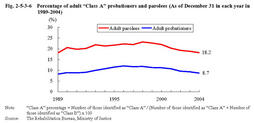| Previous Next Index Image Index Year Selection | |
|
|
4 Treatment for probationers and parolees In order to enhance the effects of probationary supervision,the classified treatment system,the categorized treatment system,and the intermediate treatment system for long-term sentenced parolees are implemented.
(1) Classified treatment system The classified treatment system was introduced in1971and its classification criteria were revised in1986.Based on the fixed criteria,probationers and parolees are classified into Class A or Class B according to the expected level of difficulty in treating them.For Class A probationers/parolees who have grave problems with their predispositions and environments and are expected to be difficult to treat,probation officers in charge are required to communicate and consult with volunteer probation officers,and to make well-planned and intensive meetings with probationers/parolees,their families,and related parties to give proper guidance and advice.Through such an active and planned involvement,probation officers are expected to exercise their expertise in an efficient way to enhance the effects of probationary supervision.
Fig.2-5-3-6 shows the percentage of probationers and parolees who were identified as"Class A"(those who are difficult to treat)since1989. Fig.2-5-3-6 Percentage of adult"Class A"probationers and parolees(As of December31in each year in1989-2004) (2) Categorized treatment system The Categorized treatment system is a system whereby probationers and parolees are divided according to the nature of their crime or delinquency,environmental conditions and other circumstances,and supervision is carried out focusing on the characteristics of each category.This system was introduced in1990,and the number of categories was revised in2003to13.For advancement in the knowledge on treatment and skills of probation officers and volunteer probation officers,and for the standardization of treatment contents,the Ministry of Justice created a treatment manual,which contains detailed explanation of characteristics and problems of those divided into each category,examples of establishing special conditions to be observed,concrete methods of treatment,introduction of organizations and social resources that can be utilized for treatment and how to use them.
Table2-5-3-7 shows the major treatment categories of probationers and parolees(as of December31,2004). "Stimulant drug offenses"accounted for the largest portion(24.4%of adult parolees and13.3%of adult probationers)."Sexual offenses"accounted for4.1%of adult parolees and5.6%of adult probationers. Individual supervision of a categorized probationer/parolee is carried out based on the treatment manual prepared for the supervision of each category,and in some probation offices,group treatment is implemented for the probationers/parolees or their guarantors in some categories.In2004,26offices held a total of36meetings for guarantor of stimulant drug offenders,and a total of678guarantors participated(Source:The Rehabilitation Bureau,Ministry of Justice). Table2-5-3-7 Number and percentage of probationers/parolees by treatment category(As of December31,2004) (3) Intermediate treatment for long-term sentenced adult parolees The Intermediate treatment system was established to enhance parole supervision for long-term sentenced parolees who are to serve a sentence of eight years imprisonment or more including life-imprisonment.
The intermediate treatment is a system whereby a long-term sentenced parolee is accommodated in a halfway house for a month from the release on parole,if such a treatment is deemed to be reasonable for him/her by the regional parole board and he/she consents.The purpose is to provide those parolees with training for daily living and occupational support and to enable them to have a prompt and smooth return to life in the society.In2004,99parolees(down by six persons from the previous year)were subject to intermediate treatment(Source:The Rehabilitation Bureau,Ministry of Justice). |

